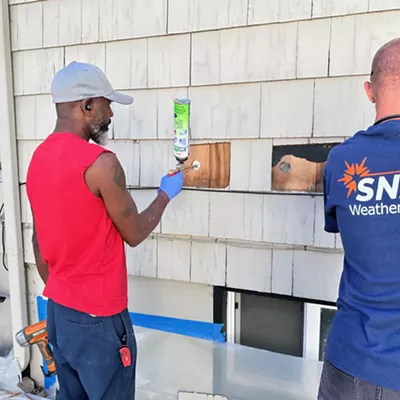The Spokesman-Review is a shell of its former self. That's not in dispute, nor is it hyperbole.
Indeed, a recent announcement that the Cowles family-owned paper is looking to cut 5 percent of its workforce came as no big surprise. It's almost as if staff cuts are an annual October tradition, like the arrival of pumpkin spice everything and the World Series.
In the past decade, the Spokesman has seen its staff across news and business departments shrink by more than half, down from a high of nearly 800. In that time, large staff cuts — buyouts and layoffs — have been part of the wider narrative of a struggling daily newspaper industry faced with declining revenue and large overhead costs. In 2008, at least 21 newsroom staffers were laid off, which at the time was the fourth set of layoffs in seven years, according to an employee's blog at the time. Longtime fixtures like Jim Kershner and John Blanchette took buyouts, but have continued on in part-time freelance roles. Further cost-saving measures have come in eliminating the North Idaho section and consolidating news sections in print, translating to a thinner paper.
Since 1994, daily circulation has dropped to about 68,000, from a high of more than 115,000.
With that kind of drop in subscription revenue, combined with shrinking advertising income, staff cuts are understandable. This latest round of cuts is characterized by both management and news staff as fairly typical in advance of the coming year.
"We're in budget season," says Kathleen Coleman, director of sales and marketing. "It's a retooling that any company does around budget time, especially around new product development in 2015. It just kind of helps us plan where we're going forward."
Rick Edmonds analyzes the newspaper industry for the Poynter Institute, which tracks media trends. He says these cuts aren't eyebrow-raising compared to the rest of the industry.
"I would agree that 5 percent is not unusually high," Edmonds says, noting that cuts at newspapers, particularly regional dailies likes the Spokesman, are the new normal. "It's pretty much happening all over. Good papers, bad papers, they're all dealing with continuing print losses."
Spokesman Editor Gary Graham is tasked with leading a slimmed-down staff going forward, and doing more with less.
"We're not giving up, we're moving on," he says. "Even with reductions, we still remain the largest newsgathering operation in Eastern Washington and North Idaho."
Graham is no stranger to layoffs, having been with the Spokesman through the worst of the cuts in the past decade. He remembers one round of layoffs, before he was editor, where the entire news staff was gathered, and people getting pink slips had their names called out to the entire room.
"I can guarantee you [that] won't happen again as long as I'm here," he says. "It's just not the humane thing to do."
Digital dimes
To call the Spokesman just a newspaper is, in this digital age, a misnomer. Like every news outlet, it increasingly focuses on expanding news delivery online. Coleman, in charge of digital operations, says the focus on web and mobile properties shows that while print readership may be decreasing, overall reach online is up.
The desktop website, Spokesman.com, gets about 650,000 unique visitors per month, and 3.6 million total monthly page views, according to Coleman. On mobile phones, the site averages 350,000 unique monthly visitors.
A separate high school sports site, NWPrepsNow.com, a collaboration with KHQ-TV, which the Cowles family also owns, attracts 40,000 users per month, Coleman says.
Despite this growth in online presence, the Spokesman is faced with the same quandary as other news companies with print legacies: Online advertising doesn't support the full operation. Advertising in print still brings in much more money; ads in online platforms translate to digital dimes.
That reality is not lost on publisher W. Stacey Cowles, whose family has owned the Spokesman-Review since 1894. He notes that while cutting back on print days, such as going to a three-day-per-week model, has been tried by other papers, it's not something the Spokesman is currently considering.
"For us and all our daily newspaper brethren, at least 80 percent of our revenue is still tied to print," Cowles says in an email.
In other words: For as much talk as there is about newspapers dying and digital forms of news being the only way forward, the bread and butter is, for the time being, still in print. (Full disclosure: The Inlander is distributing more print copies than ever in its 21-year history, and the paper has the highest market penetration of any weekly in the nation, according to independent Media Audit analysis.)
Downsizing property
With less space necessary to house employees, the Spokesman is renting out space in the Review Tower. The newsroom was previously condensed onto the fourth floor after layoffs and will soon move to the second floor, leaving the fourth and fifth floors for leasing.
The daily paper is certainly not unique in leveraging its property. The New York Times notably built a large, sleek, modern headquarters in midtown Manhattan, only to sell its stake and lease back the space. That's essentially what the Spokesman has already done with its Review Tower headquarters, albeit with Centennial Property Management, which the Cowles Company also owns.
Then there's case of the Indianapolis Star, which, like the Spokesman, was for much of its history owned by a local family. The paper recently sold its headquarters building and is moving into a downtown Indianapolis mall, into the space left vacant when Nordstrom moved out.
That option of moving out of the iconic Review Tower and into a mall doesn't seem to be in the cards for the Spokesman.
"As long as rent is affordable and the landlord wants us around, we're in Review Tower to stay," Cowles notes.
The Spokesman has one perk going for it that distinguishes it from the Star. If the Spokesman were to consider moving into a downtown mall, namely River Park Square, the paperwork would seemingly be easy. After all, the Cowles family already owns both. ♦
Scott A. Leadingham is director of education for the Society of Professional Journalists and editor of its magazine, Quill.
CORRECTION: Because of an editing error, this article had incorrectly stated that the Spokesman closed its North Idaho bureau. The paper has previously laid off staff there and eliminated its Idaho section, but maintains an office in Coeur d’Alene.






















